The Theory of Egoism
VerifiedAdded on 2022/09/16
|13
|4000
|31
AI Summary
Contribute Materials
Your contribution can guide someone’s learning journey. Share your
documents today.
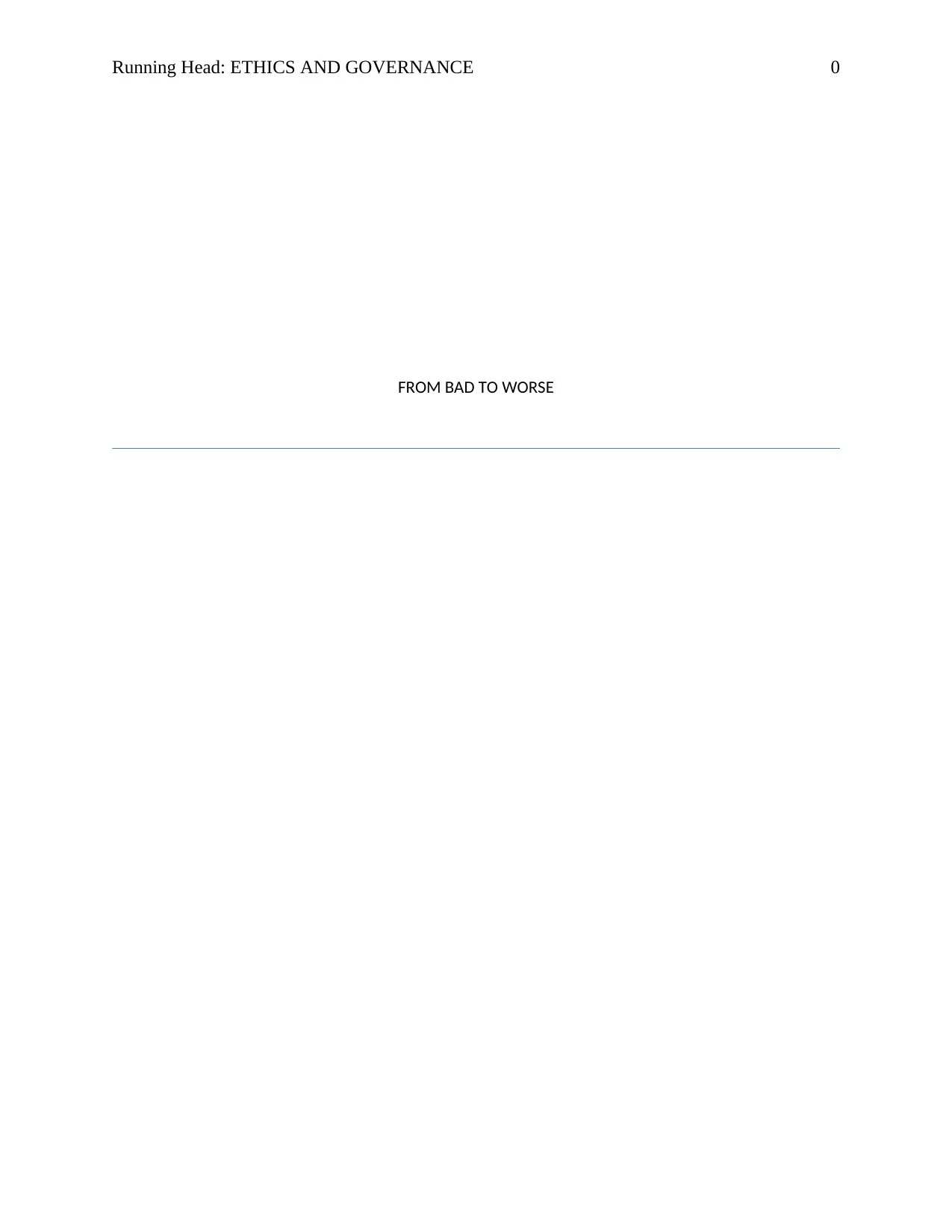
Running Head: ETHICS AND GOVERNANCE 0
FROM BAD TO WORSE
FROM BAD TO WORSE
Secure Best Marks with AI Grader
Need help grading? Try our AI Grader for instant feedback on your assignments.

ETHICS AND GOVERNANCE 2
Executive summary
The assignment is on the case study “from bad to worse”. Various ethical theories are discussed.
There is a application of AAA decision making model. In the last part, principals, threats and
safeguards are being discussed. The assignment is all about application of various ethical
theories and models in the business world.
Executive summary
The assignment is on the case study “from bad to worse”. Various ethical theories are discussed.
There is a application of AAA decision making model. In the last part, principals, threats and
safeguards are being discussed. The assignment is all about application of various ethical
theories and models in the business world.
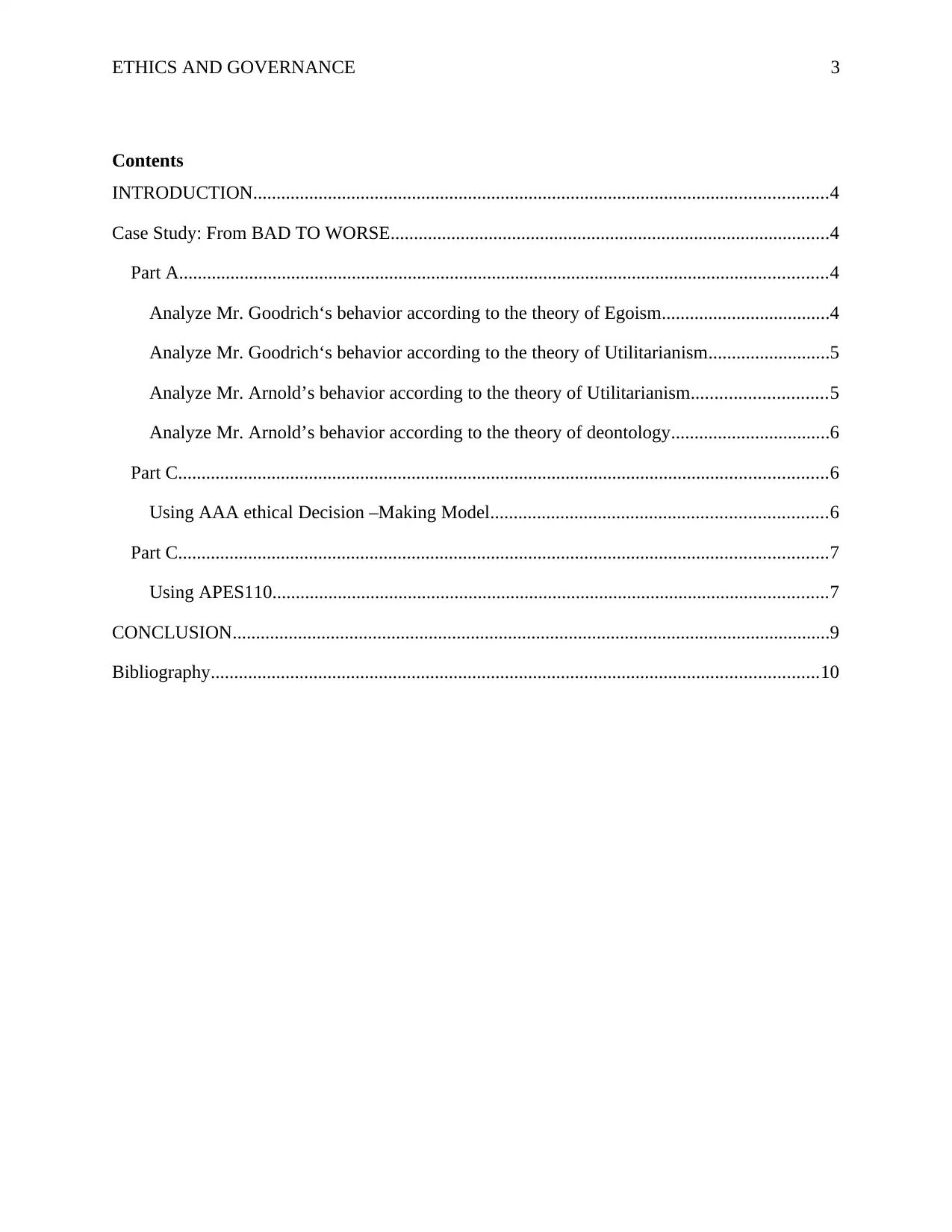
ETHICS AND GOVERNANCE 3
Contents
INTRODUCTION...........................................................................................................................4
Case Study: From BAD TO WORSE..............................................................................................4
Part A...........................................................................................................................................4
Analyze Mr. Goodrich‘s behavior according to the theory of Egoism....................................4
Analyze Mr. Goodrich‘s behavior according to the theory of Utilitarianism..........................5
Analyze Mr. Arnold’s behavior according to the theory of Utilitarianism.............................5
Analyze Mr. Arnold’s behavior according to the theory of deontology..................................6
Part C...........................................................................................................................................6
Using AAA ethical Decision –Making Model........................................................................6
Part C...........................................................................................................................................7
Using APES110.......................................................................................................................7
CONCLUSION................................................................................................................................9
Bibliography..................................................................................................................................10
Contents
INTRODUCTION...........................................................................................................................4
Case Study: From BAD TO WORSE..............................................................................................4
Part A...........................................................................................................................................4
Analyze Mr. Goodrich‘s behavior according to the theory of Egoism....................................4
Analyze Mr. Goodrich‘s behavior according to the theory of Utilitarianism..........................5
Analyze Mr. Arnold’s behavior according to the theory of Utilitarianism.............................5
Analyze Mr. Arnold’s behavior according to the theory of deontology..................................6
Part C...........................................................................................................................................6
Using AAA ethical Decision –Making Model........................................................................6
Part C...........................................................................................................................................7
Using APES110.......................................................................................................................7
CONCLUSION................................................................................................................................9
Bibliography..................................................................................................................................10
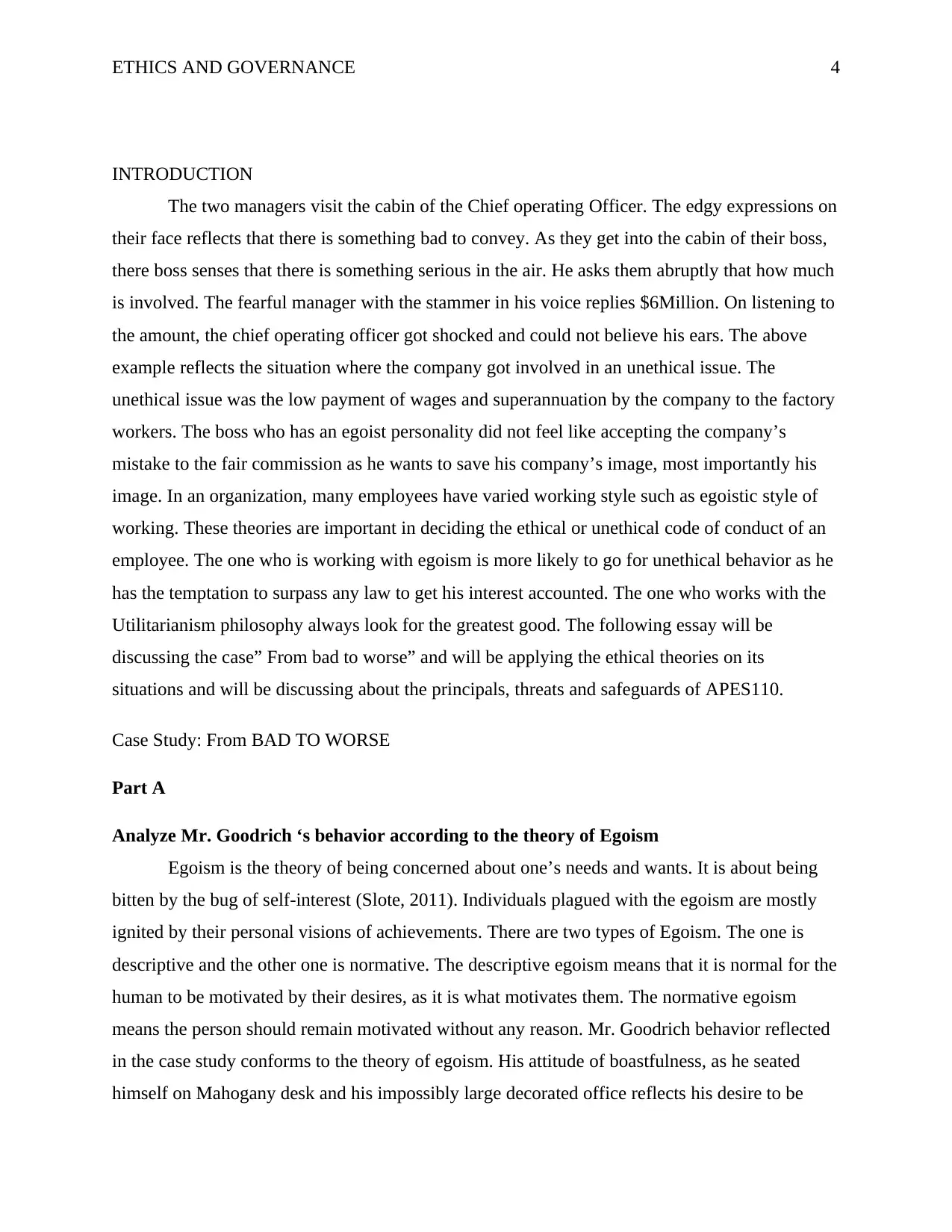
ETHICS AND GOVERNANCE 4
INTRODUCTION
The two managers visit the cabin of the Chief operating Officer. The edgy expressions on
their face reflects that there is something bad to convey. As they get into the cabin of their boss,
there boss senses that there is something serious in the air. He asks them abruptly that how much
is involved. The fearful manager with the stammer in his voice replies $6Million. On listening to
the amount, the chief operating officer got shocked and could not believe his ears. The above
example reflects the situation where the company got involved in an unethical issue. The
unethical issue was the low payment of wages and superannuation by the company to the factory
workers. The boss who has an egoist personality did not feel like accepting the company’s
mistake to the fair commission as he wants to save his company’s image, most importantly his
image. In an organization, many employees have varied working style such as egoistic style of
working. These theories are important in deciding the ethical or unethical code of conduct of an
employee. The one who is working with egoism is more likely to go for unethical behavior as he
has the temptation to surpass any law to get his interest accounted. The one who works with the
Utilitarianism philosophy always look for the greatest good. The following essay will be
discussing the case” From bad to worse” and will be applying the ethical theories on its
situations and will be discussing about the principals, threats and safeguards of APES110.
Case Study: From BAD TO WORSE
Part A
Analyze Mr. Goodrich ‘s behavior according to the theory of Egoism
Egoism is the theory of being concerned about one’s needs and wants. It is about being
bitten by the bug of self-interest (Slote, 2011). Individuals plagued with the egoism are mostly
ignited by their personal visions of achievements. There are two types of Egoism. The one is
descriptive and the other one is normative. The descriptive egoism means that it is normal for the
human to be motivated by their desires, as it is what motivates them. The normative egoism
means the person should remain motivated without any reason. Mr. Goodrich behavior reflected
in the case study conforms to the theory of egoism. His attitude of boastfulness, as he seated
himself on Mahogany desk and his impossibly large decorated office reflects his desire to be
INTRODUCTION
The two managers visit the cabin of the Chief operating Officer. The edgy expressions on
their face reflects that there is something bad to convey. As they get into the cabin of their boss,
there boss senses that there is something serious in the air. He asks them abruptly that how much
is involved. The fearful manager with the stammer in his voice replies $6Million. On listening to
the amount, the chief operating officer got shocked and could not believe his ears. The above
example reflects the situation where the company got involved in an unethical issue. The
unethical issue was the low payment of wages and superannuation by the company to the factory
workers. The boss who has an egoist personality did not feel like accepting the company’s
mistake to the fair commission as he wants to save his company’s image, most importantly his
image. In an organization, many employees have varied working style such as egoistic style of
working. These theories are important in deciding the ethical or unethical code of conduct of an
employee. The one who is working with egoism is more likely to go for unethical behavior as he
has the temptation to surpass any law to get his interest accounted. The one who works with the
Utilitarianism philosophy always look for the greatest good. The following essay will be
discussing the case” From bad to worse” and will be applying the ethical theories on its
situations and will be discussing about the principals, threats and safeguards of APES110.
Case Study: From BAD TO WORSE
Part A
Analyze Mr. Goodrich ‘s behavior according to the theory of Egoism
Egoism is the theory of being concerned about one’s needs and wants. It is about being
bitten by the bug of self-interest (Slote, 2011). Individuals plagued with the egoism are mostly
ignited by their personal visions of achievements. There are two types of Egoism. The one is
descriptive and the other one is normative. The descriptive egoism means that it is normal for the
human to be motivated by their desires, as it is what motivates them. The normative egoism
means the person should remain motivated without any reason. Mr. Goodrich behavior reflected
in the case study conforms to the theory of egoism. His attitude of boastfulness, as he seated
himself on Mahogany desk and his impossibly large decorated office reflects his desire to be
Secure Best Marks with AI Grader
Need help grading? Try our AI Grader for instant feedback on your assignments.
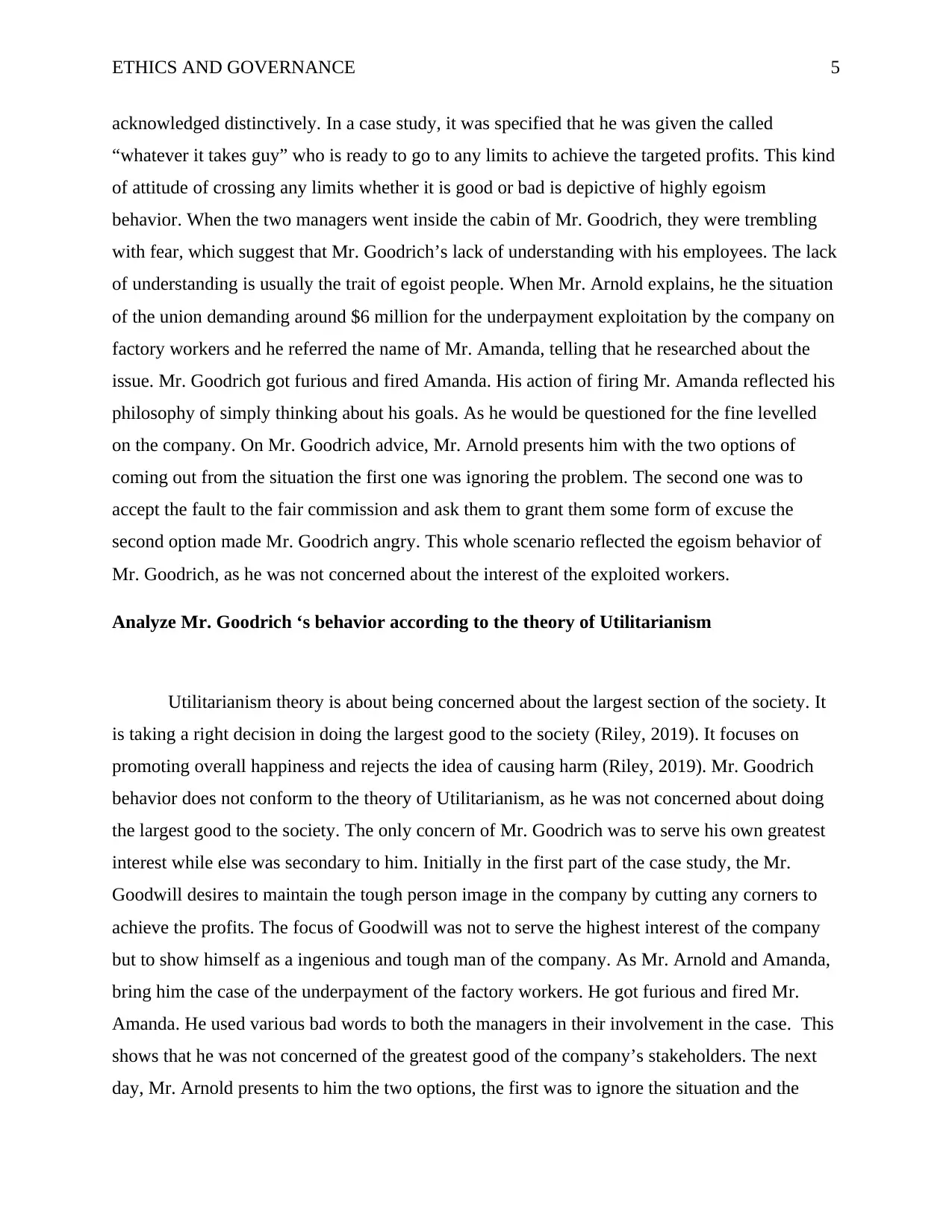
ETHICS AND GOVERNANCE 5
acknowledged distinctively. In a case study, it was specified that he was given the called
“whatever it takes guy” who is ready to go to any limits to achieve the targeted profits. This kind
of attitude of crossing any limits whether it is good or bad is depictive of highly egoism
behavior. When the two managers went inside the cabin of Mr. Goodrich, they were trembling
with fear, which suggest that Mr. Goodrich’s lack of understanding with his employees. The lack
of understanding is usually the trait of egoist people. When Mr. Arnold explains, he the situation
of the union demanding around $6 million for the underpayment exploitation by the company on
factory workers and he referred the name of Mr. Amanda, telling that he researched about the
issue. Mr. Goodrich got furious and fired Amanda. His action of firing Mr. Amanda reflected his
philosophy of simply thinking about his goals. As he would be questioned for the fine levelled
on the company. On Mr. Goodrich advice, Mr. Arnold presents him with the two options of
coming out from the situation the first one was ignoring the problem. The second one was to
accept the fault to the fair commission and ask them to grant them some form of excuse the
second option made Mr. Goodrich angry. This whole scenario reflected the egoism behavior of
Mr. Goodrich, as he was not concerned about the interest of the exploited workers.
Analyze Mr. Goodrich ‘s behavior according to the theory of Utilitarianism
Utilitarianism theory is about being concerned about the largest section of the society. It
is taking a right decision in doing the largest good to the society (Riley, 2019). It focuses on
promoting overall happiness and rejects the idea of causing harm (Riley, 2019). Mr. Goodrich
behavior does not conform to the theory of Utilitarianism, as he was not concerned about doing
the largest good to the society. The only concern of Mr. Goodrich was to serve his own greatest
interest while else was secondary to him. Initially in the first part of the case study, the Mr.
Goodwill desires to maintain the tough person image in the company by cutting any corners to
achieve the profits. The focus of Goodwill was not to serve the highest interest of the company
but to show himself as a ingenious and tough man of the company. As Mr. Arnold and Amanda,
bring him the case of the underpayment of the factory workers. He got furious and fired Mr.
Amanda. He used various bad words to both the managers in their involvement in the case. This
shows that he was not concerned of the greatest good of the company’s stakeholders. The next
day, Mr. Arnold presents to him the two options, the first was to ignore the situation and the
acknowledged distinctively. In a case study, it was specified that he was given the called
“whatever it takes guy” who is ready to go to any limits to achieve the targeted profits. This kind
of attitude of crossing any limits whether it is good or bad is depictive of highly egoism
behavior. When the two managers went inside the cabin of Mr. Goodrich, they were trembling
with fear, which suggest that Mr. Goodrich’s lack of understanding with his employees. The lack
of understanding is usually the trait of egoist people. When Mr. Arnold explains, he the situation
of the union demanding around $6 million for the underpayment exploitation by the company on
factory workers and he referred the name of Mr. Amanda, telling that he researched about the
issue. Mr. Goodrich got furious and fired Amanda. His action of firing Mr. Amanda reflected his
philosophy of simply thinking about his goals. As he would be questioned for the fine levelled
on the company. On Mr. Goodrich advice, Mr. Arnold presents him with the two options of
coming out from the situation the first one was ignoring the problem. The second one was to
accept the fault to the fair commission and ask them to grant them some form of excuse the
second option made Mr. Goodrich angry. This whole scenario reflected the egoism behavior of
Mr. Goodrich, as he was not concerned about the interest of the exploited workers.
Analyze Mr. Goodrich ‘s behavior according to the theory of Utilitarianism
Utilitarianism theory is about being concerned about the largest section of the society. It
is taking a right decision in doing the largest good to the society (Riley, 2019). It focuses on
promoting overall happiness and rejects the idea of causing harm (Riley, 2019). Mr. Goodrich
behavior does not conform to the theory of Utilitarianism, as he was not concerned about doing
the largest good to the society. The only concern of Mr. Goodrich was to serve his own greatest
interest while else was secondary to him. Initially in the first part of the case study, the Mr.
Goodwill desires to maintain the tough person image in the company by cutting any corners to
achieve the profits. The focus of Goodwill was not to serve the highest interest of the company
but to show himself as a ingenious and tough man of the company. As Mr. Arnold and Amanda,
bring him the case of the underpayment of the factory workers. He got furious and fired Mr.
Amanda. He used various bad words to both the managers in their involvement in the case. This
shows that he was not concerned of the greatest good of the company’s stakeholders. The next
day, Mr. Arnold presents to him the two options, the first was to ignore the situation and the

ETHICS AND GOVERNANCE 6
second one was to accept the mistake to the Fair Commission. On second option, Mr. Goodrich
got furious, as the second option would undermine the image of the company. This shows that he
was concerned about the greatest good of the company but it was because his interest was linked
to the company.
Analyze Mr. Arnold’s behavior according to the theory of Utilitarianism
Mr. Arnold who is the account manager at some parts of the case study conforms to the
theory of Utilitarianism. Initially, Mr. Arnold brings the concern to Mr. Goodrich despite
knowing the egoism personality of Mr. Goodrich. This reflects his interest towards caring for the
largest good of the people. As an accountant, he would have dismissed the case without
considering it. His bold attitude to discuss it with Mr. Goodrich speaks everything. As the matter
goes on, Mr. Goodrich asked Mr. Arnold to come up with the solution. He presented to him two
solutions; the first one was not to consider the case while the second one was to accept it
genuinely. His reflection of the second case expresses his desire to do the good. As an account’s
manager, he had no other option except to listen to Mr. Arnold, as he was the Chief Operating
Officer of the company, going against him means losing on to one’s career. As Mr. Goodrich got
furious on looking at the second option, he asked Mr. Arnold to delete all the files of this report
so that no one I the company gets to know about the issue. After listening to Mr. Goodrich’s
order, he could do nothing but to a step back and do it. The position of Mr. Arnold did not allow
him to revolt his boss’s decision so it could be concluded that Mr. Arnold conforms to the theory
of utilitarianism but the full conformation would take place if he had the bravery to go against
the tide to lose the job.
Analyze Mr. Arnold’s behavior according to the theory of deontology
The theory of deontology states that an action is considered good or bad according to the
set of rules provided to him (Landau, 2007).For example cheating a friend just to save him is not
a right action as it involves morally unjust action, which is cheating. Mr. Arnold behavior did not
conform to the theory of deontology. In his ethics, Mr. Arnold was flexible. He did not stick to
the actions completely. As Amanda was fired, he advised Mr. Arnold to take care of his job by
second one was to accept the mistake to the Fair Commission. On second option, Mr. Goodrich
got furious, as the second option would undermine the image of the company. This shows that he
was concerned about the greatest good of the company but it was because his interest was linked
to the company.
Analyze Mr. Arnold’s behavior according to the theory of Utilitarianism
Mr. Arnold who is the account manager at some parts of the case study conforms to the
theory of Utilitarianism. Initially, Mr. Arnold brings the concern to Mr. Goodrich despite
knowing the egoism personality of Mr. Goodrich. This reflects his interest towards caring for the
largest good of the people. As an accountant, he would have dismissed the case without
considering it. His bold attitude to discuss it with Mr. Goodrich speaks everything. As the matter
goes on, Mr. Goodrich asked Mr. Arnold to come up with the solution. He presented to him two
solutions; the first one was not to consider the case while the second one was to accept it
genuinely. His reflection of the second case expresses his desire to do the good. As an account’s
manager, he had no other option except to listen to Mr. Arnold, as he was the Chief Operating
Officer of the company, going against him means losing on to one’s career. As Mr. Goodrich got
furious on looking at the second option, he asked Mr. Arnold to delete all the files of this report
so that no one I the company gets to know about the issue. After listening to Mr. Goodrich’s
order, he could do nothing but to a step back and do it. The position of Mr. Arnold did not allow
him to revolt his boss’s decision so it could be concluded that Mr. Arnold conforms to the theory
of utilitarianism but the full conformation would take place if he had the bravery to go against
the tide to lose the job.
Analyze Mr. Arnold’s behavior according to the theory of deontology
The theory of deontology states that an action is considered good or bad according to the
set of rules provided to him (Landau, 2007).For example cheating a friend just to save him is not
a right action as it involves morally unjust action, which is cheating. Mr. Arnold behavior did not
conform to the theory of deontology. In his ethics, Mr. Arnold was flexible. He did not stick to
the actions completely. As Amanda was fired, he advised Mr. Arnold to take care of his job by
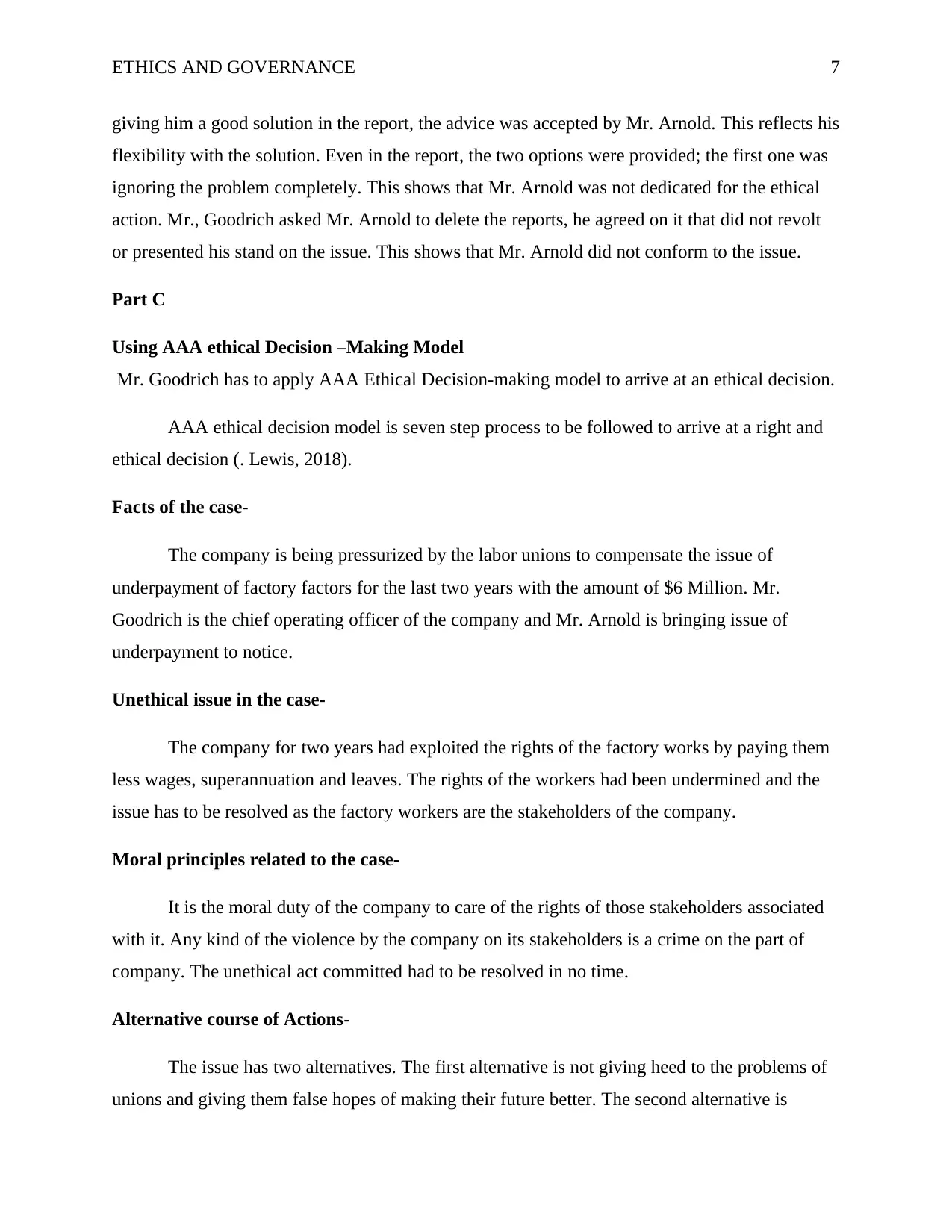
ETHICS AND GOVERNANCE 7
giving him a good solution in the report, the advice was accepted by Mr. Arnold. This reflects his
flexibility with the solution. Even in the report, the two options were provided; the first one was
ignoring the problem completely. This shows that Mr. Arnold was not dedicated for the ethical
action. Mr., Goodrich asked Mr. Arnold to delete the reports, he agreed on it that did not revolt
or presented his stand on the issue. This shows that Mr. Arnold did not conform to the issue.
Part C
Using AAA ethical Decision –Making Model
Mr. Goodrich has to apply AAA Ethical Decision-making model to arrive at an ethical decision.
AAA ethical decision model is seven step process to be followed to arrive at a right and
ethical decision (. Lewis, 2018).
Facts of the case-
The company is being pressurized by the labor unions to compensate the issue of
underpayment of factory factors for the last two years with the amount of $6 Million. Mr.
Goodrich is the chief operating officer of the company and Mr. Arnold is bringing issue of
underpayment to notice.
Unethical issue in the case-
The company for two years had exploited the rights of the factory works by paying them
less wages, superannuation and leaves. The rights of the workers had been undermined and the
issue has to be resolved as the factory workers are the stakeholders of the company.
Moral principles related to the case-
It is the moral duty of the company to care of the rights of those stakeholders associated
with it. Any kind of the violence by the company on its stakeholders is a crime on the part of
company. The unethical act committed had to be resolved in no time.
Alternative course of Actions-
The issue has two alternatives. The first alternative is not giving heed to the problems of
unions and giving them false hopes of making their future better. The second alternative is
giving him a good solution in the report, the advice was accepted by Mr. Arnold. This reflects his
flexibility with the solution. Even in the report, the two options were provided; the first one was
ignoring the problem completely. This shows that Mr. Arnold was not dedicated for the ethical
action. Mr., Goodrich asked Mr. Arnold to delete the reports, he agreed on it that did not revolt
or presented his stand on the issue. This shows that Mr. Arnold did not conform to the issue.
Part C
Using AAA ethical Decision –Making Model
Mr. Goodrich has to apply AAA Ethical Decision-making model to arrive at an ethical decision.
AAA ethical decision model is seven step process to be followed to arrive at a right and
ethical decision (. Lewis, 2018).
Facts of the case-
The company is being pressurized by the labor unions to compensate the issue of
underpayment of factory factors for the last two years with the amount of $6 Million. Mr.
Goodrich is the chief operating officer of the company and Mr. Arnold is bringing issue of
underpayment to notice.
Unethical issue in the case-
The company for two years had exploited the rights of the factory works by paying them
less wages, superannuation and leaves. The rights of the workers had been undermined and the
issue has to be resolved as the factory workers are the stakeholders of the company.
Moral principles related to the case-
It is the moral duty of the company to care of the rights of those stakeholders associated
with it. Any kind of the violence by the company on its stakeholders is a crime on the part of
company. The unethical act committed had to be resolved in no time.
Alternative course of Actions-
The issue has two alternatives. The first alternative is not giving heed to the problems of
unions and giving them false hopes of making their future better. The second alternative is
Paraphrase This Document
Need a fresh take? Get an instant paraphrase of this document with our AI Paraphraser
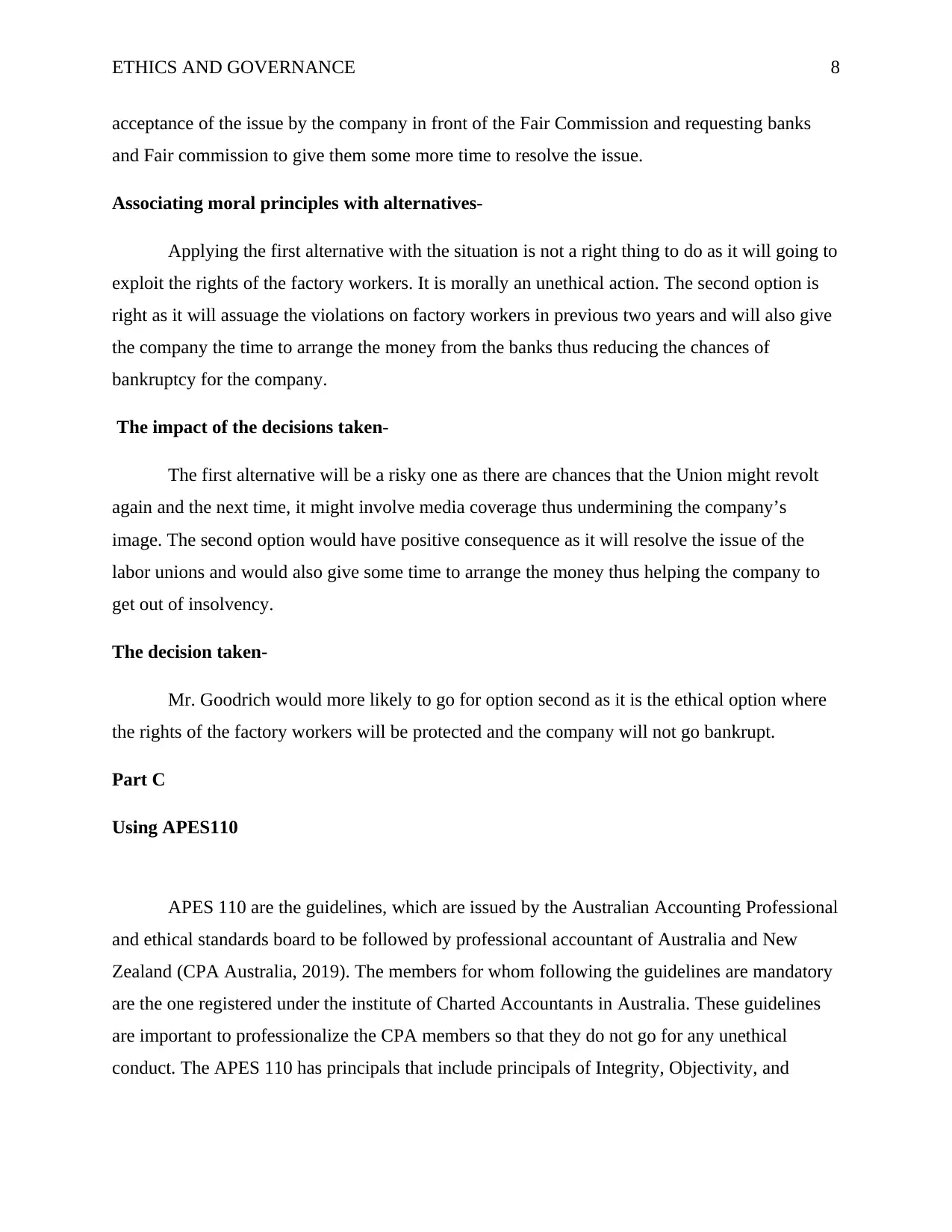
ETHICS AND GOVERNANCE 8
acceptance of the issue by the company in front of the Fair Commission and requesting banks
and Fair commission to give them some more time to resolve the issue.
Associating moral principles with alternatives-
Applying the first alternative with the situation is not a right thing to do as it will going to
exploit the rights of the factory workers. It is morally an unethical action. The second option is
right as it will assuage the violations on factory workers in previous two years and will also give
the company the time to arrange the money from the banks thus reducing the chances of
bankruptcy for the company.
The impact of the decisions taken-
The first alternative will be a risky one as there are chances that the Union might revolt
again and the next time, it might involve media coverage thus undermining the company’s
image. The second option would have positive consequence as it will resolve the issue of the
labor unions and would also give some time to arrange the money thus helping the company to
get out of insolvency.
The decision taken-
Mr. Goodrich would more likely to go for option second as it is the ethical option where
the rights of the factory workers will be protected and the company will not go bankrupt.
Part C
Using APES110
APES 110 are the guidelines, which are issued by the Australian Accounting Professional
and ethical standards board to be followed by professional accountant of Australia and New
Zealand (CPA Australia, 2019). The members for whom following the guidelines are mandatory
are the one registered under the institute of Charted Accountants in Australia. These guidelines
are important to professionalize the CPA members so that they do not go for any unethical
conduct. The APES 110 has principals that include principals of Integrity, Objectivity, and
acceptance of the issue by the company in front of the Fair Commission and requesting banks
and Fair commission to give them some more time to resolve the issue.
Associating moral principles with alternatives-
Applying the first alternative with the situation is not a right thing to do as it will going to
exploit the rights of the factory workers. It is morally an unethical action. The second option is
right as it will assuage the violations on factory workers in previous two years and will also give
the company the time to arrange the money from the banks thus reducing the chances of
bankruptcy for the company.
The impact of the decisions taken-
The first alternative will be a risky one as there are chances that the Union might revolt
again and the next time, it might involve media coverage thus undermining the company’s
image. The second option would have positive consequence as it will resolve the issue of the
labor unions and would also give some time to arrange the money thus helping the company to
get out of insolvency.
The decision taken-
Mr. Goodrich would more likely to go for option second as it is the ethical option where
the rights of the factory workers will be protected and the company will not go bankrupt.
Part C
Using APES110
APES 110 are the guidelines, which are issued by the Australian Accounting Professional
and ethical standards board to be followed by professional accountant of Australia and New
Zealand (CPA Australia, 2019). The members for whom following the guidelines are mandatory
are the one registered under the institute of Charted Accountants in Australia. These guidelines
are important to professionalize the CPA members so that they do not go for any unethical
conduct. The APES 110 has principals that include principals of Integrity, Objectivity, and
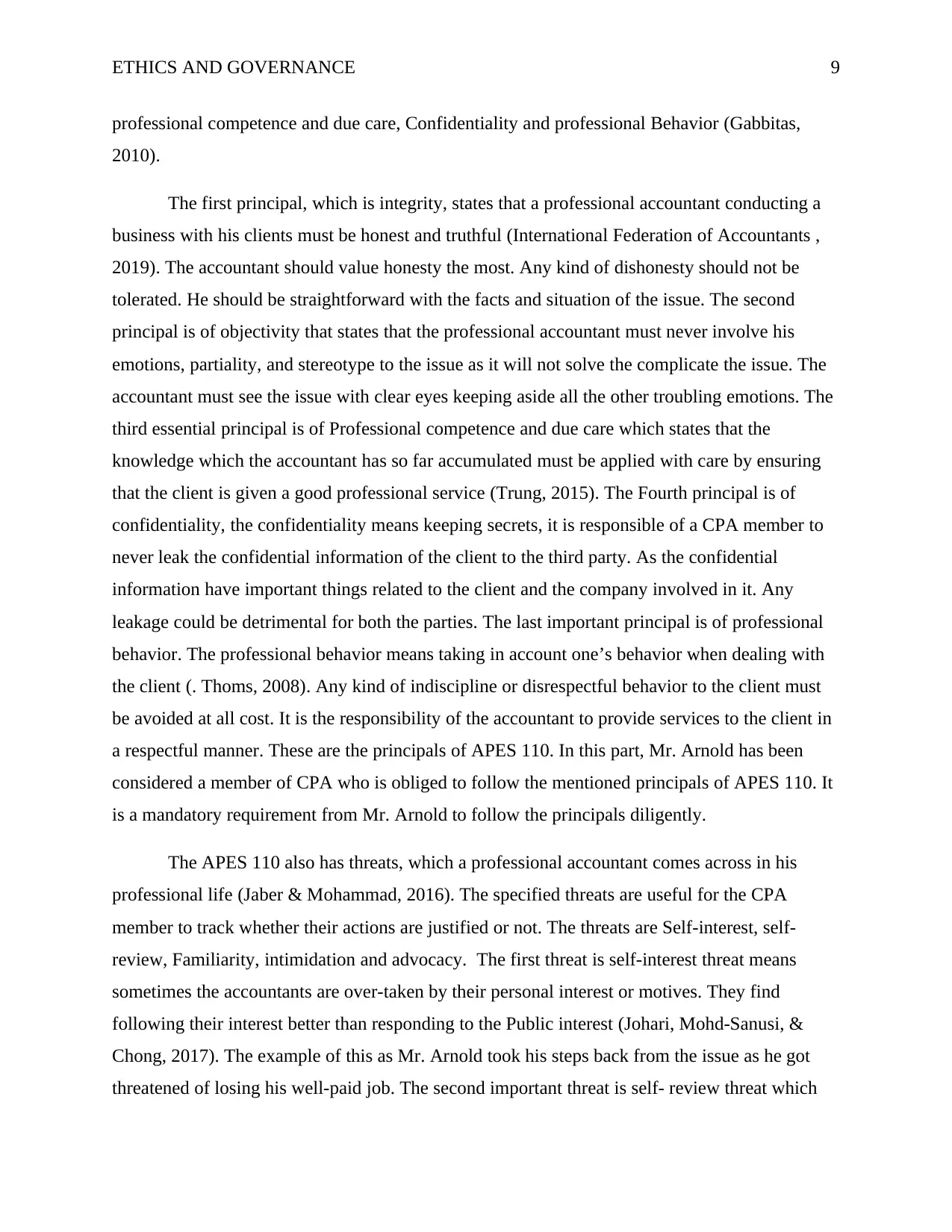
ETHICS AND GOVERNANCE 9
professional competence and due care, Confidentiality and professional Behavior (Gabbitas,
2010).
The first principal, which is integrity, states that a professional accountant conducting a
business with his clients must be honest and truthful (International Federation of Accountants ,
2019). The accountant should value honesty the most. Any kind of dishonesty should not be
tolerated. He should be straightforward with the facts and situation of the issue. The second
principal is of objectivity that states that the professional accountant must never involve his
emotions, partiality, and stereotype to the issue as it will not solve the complicate the issue. The
accountant must see the issue with clear eyes keeping aside all the other troubling emotions. The
third essential principal is of Professional competence and due care which states that the
knowledge which the accountant has so far accumulated must be applied with care by ensuring
that the client is given a good professional service (Trung, 2015). The Fourth principal is of
confidentiality, the confidentiality means keeping secrets, it is responsible of a CPA member to
never leak the confidential information of the client to the third party. As the confidential
information have important things related to the client and the company involved in it. Any
leakage could be detrimental for both the parties. The last important principal is of professional
behavior. The professional behavior means taking in account one’s behavior when dealing with
the client (. Thoms, 2008). Any kind of indiscipline or disrespectful behavior to the client must
be avoided at all cost. It is the responsibility of the accountant to provide services to the client in
a respectful manner. These are the principals of APES 110. In this part, Mr. Arnold has been
considered a member of CPA who is obliged to follow the mentioned principals of APES 110. It
is a mandatory requirement from Mr. Arnold to follow the principals diligently.
The APES 110 also has threats, which a professional accountant comes across in his
professional life (Jaber & Mohammad, 2016). The specified threats are useful for the CPA
member to track whether their actions are justified or not. The threats are Self-interest, self-
review, Familiarity, intimidation and advocacy. The first threat is self-interest threat means
sometimes the accountants are over-taken by their personal interest or motives. They find
following their interest better than responding to the Public interest (Johari, Mohd‐Sanusi, &
Chong, 2017). The example of this as Mr. Arnold took his steps back from the issue as he got
threatened of losing his well-paid job. The second important threat is self- review threat which
professional competence and due care, Confidentiality and professional Behavior (Gabbitas,
2010).
The first principal, which is integrity, states that a professional accountant conducting a
business with his clients must be honest and truthful (International Federation of Accountants ,
2019). The accountant should value honesty the most. Any kind of dishonesty should not be
tolerated. He should be straightforward with the facts and situation of the issue. The second
principal is of objectivity that states that the professional accountant must never involve his
emotions, partiality, and stereotype to the issue as it will not solve the complicate the issue. The
accountant must see the issue with clear eyes keeping aside all the other troubling emotions. The
third essential principal is of Professional competence and due care which states that the
knowledge which the accountant has so far accumulated must be applied with care by ensuring
that the client is given a good professional service (Trung, 2015). The Fourth principal is of
confidentiality, the confidentiality means keeping secrets, it is responsible of a CPA member to
never leak the confidential information of the client to the third party. As the confidential
information have important things related to the client and the company involved in it. Any
leakage could be detrimental for both the parties. The last important principal is of professional
behavior. The professional behavior means taking in account one’s behavior when dealing with
the client (. Thoms, 2008). Any kind of indiscipline or disrespectful behavior to the client must
be avoided at all cost. It is the responsibility of the accountant to provide services to the client in
a respectful manner. These are the principals of APES 110. In this part, Mr. Arnold has been
considered a member of CPA who is obliged to follow the mentioned principals of APES 110. It
is a mandatory requirement from Mr. Arnold to follow the principals diligently.
The APES 110 also has threats, which a professional accountant comes across in his
professional life (Jaber & Mohammad, 2016). The specified threats are useful for the CPA
member to track whether their actions are justified or not. The threats are Self-interest, self-
review, Familiarity, intimidation and advocacy. The first threat is self-interest threat means
sometimes the accountants are over-taken by their personal interest or motives. They find
following their interest better than responding to the Public interest (Johari, Mohd‐Sanusi, &
Chong, 2017). The example of this as Mr. Arnold took his steps back from the issue as he got
threatened of losing his well-paid job. The second important threat is self- review threat which
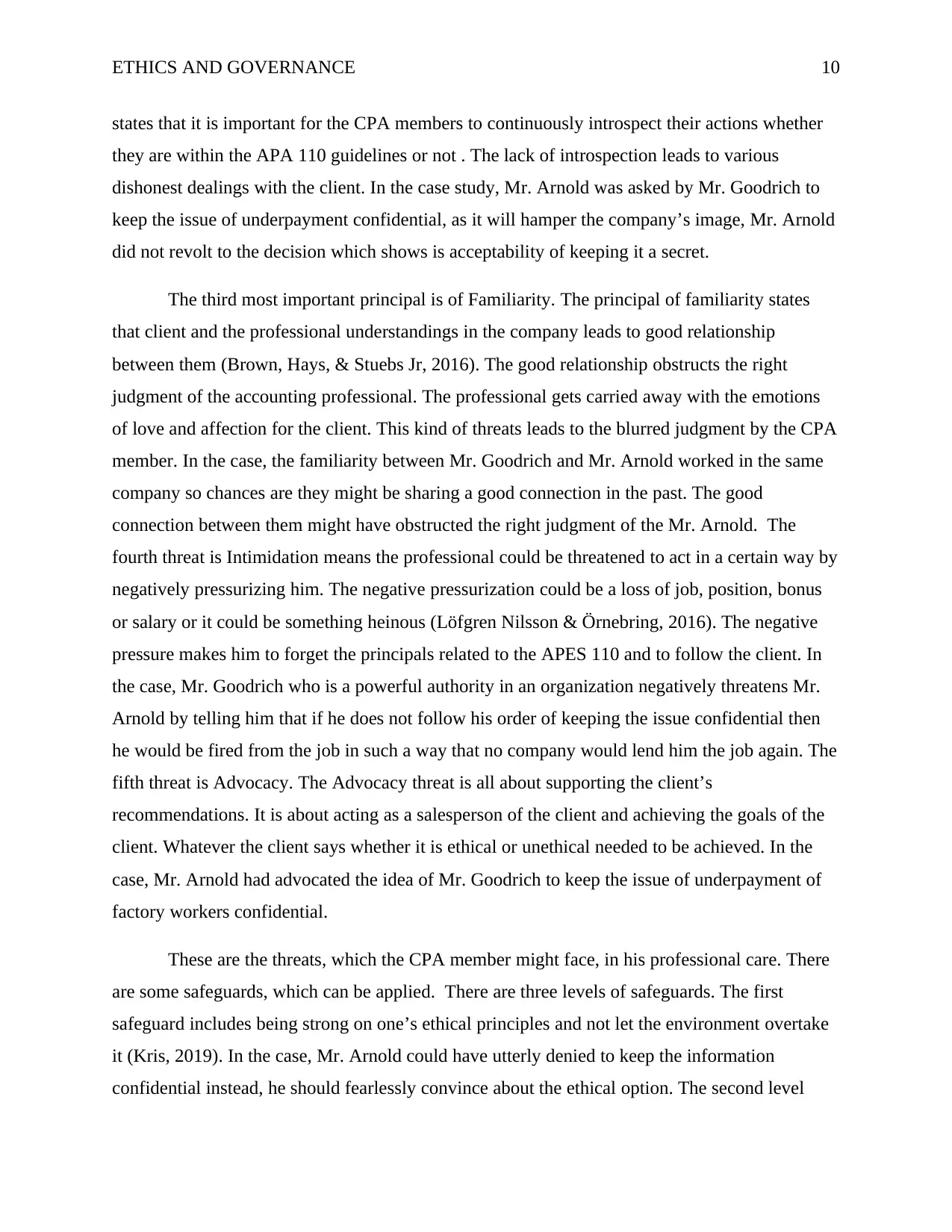
ETHICS AND GOVERNANCE 10
states that it is important for the CPA members to continuously introspect their actions whether
they are within the APA 110 guidelines or not . The lack of introspection leads to various
dishonest dealings with the client. In the case study, Mr. Arnold was asked by Mr. Goodrich to
keep the issue of underpayment confidential, as it will hamper the company’s image, Mr. Arnold
did not revolt to the decision which shows is acceptability of keeping it a secret.
The third most important principal is of Familiarity. The principal of familiarity states
that client and the professional understandings in the company leads to good relationship
between them (Brown, Hays, & Stuebs Jr, 2016). The good relationship obstructs the right
judgment of the accounting professional. The professional gets carried away with the emotions
of love and affection for the client. This kind of threats leads to the blurred judgment by the CPA
member. In the case, the familiarity between Mr. Goodrich and Mr. Arnold worked in the same
company so chances are they might be sharing a good connection in the past. The good
connection between them might have obstructed the right judgment of the Mr. Arnold. The
fourth threat is Intimidation means the professional could be threatened to act in a certain way by
negatively pressurizing him. The negative pressurization could be a loss of job, position, bonus
or salary or it could be something heinous (Löfgren Nilsson & Örnebring, 2016). The negative
pressure makes him to forget the principals related to the APES 110 and to follow the client. In
the case, Mr. Goodrich who is a powerful authority in an organization negatively threatens Mr.
Arnold by telling him that if he does not follow his order of keeping the issue confidential then
he would be fired from the job in such a way that no company would lend him the job again. The
fifth threat is Advocacy. The Advocacy threat is all about supporting the client’s
recommendations. It is about acting as a salesperson of the client and achieving the goals of the
client. Whatever the client says whether it is ethical or unethical needed to be achieved. In the
case, Mr. Arnold had advocated the idea of Mr. Goodrich to keep the issue of underpayment of
factory workers confidential.
These are the threats, which the CPA member might face, in his professional care. There
are some safeguards, which can be applied. There are three levels of safeguards. The first
safeguard includes being strong on one’s ethical principles and not let the environment overtake
it (Kris, 2019). In the case, Mr. Arnold could have utterly denied to keep the information
confidential instead, he should fearlessly convince about the ethical option. The second level
states that it is important for the CPA members to continuously introspect their actions whether
they are within the APA 110 guidelines or not . The lack of introspection leads to various
dishonest dealings with the client. In the case study, Mr. Arnold was asked by Mr. Goodrich to
keep the issue of underpayment confidential, as it will hamper the company’s image, Mr. Arnold
did not revolt to the decision which shows is acceptability of keeping it a secret.
The third most important principal is of Familiarity. The principal of familiarity states
that client and the professional understandings in the company leads to good relationship
between them (Brown, Hays, & Stuebs Jr, 2016). The good relationship obstructs the right
judgment of the accounting professional. The professional gets carried away with the emotions
of love and affection for the client. This kind of threats leads to the blurred judgment by the CPA
member. In the case, the familiarity between Mr. Goodrich and Mr. Arnold worked in the same
company so chances are they might be sharing a good connection in the past. The good
connection between them might have obstructed the right judgment of the Mr. Arnold. The
fourth threat is Intimidation means the professional could be threatened to act in a certain way by
negatively pressurizing him. The negative pressurization could be a loss of job, position, bonus
or salary or it could be something heinous (Löfgren Nilsson & Örnebring, 2016). The negative
pressure makes him to forget the principals related to the APES 110 and to follow the client. In
the case, Mr. Goodrich who is a powerful authority in an organization negatively threatens Mr.
Arnold by telling him that if he does not follow his order of keeping the issue confidential then
he would be fired from the job in such a way that no company would lend him the job again. The
fifth threat is Advocacy. The Advocacy threat is all about supporting the client’s
recommendations. It is about acting as a salesperson of the client and achieving the goals of the
client. Whatever the client says whether it is ethical or unethical needed to be achieved. In the
case, Mr. Arnold had advocated the idea of Mr. Goodrich to keep the issue of underpayment of
factory workers confidential.
These are the threats, which the CPA member might face, in his professional care. There
are some safeguards, which can be applied. There are three levels of safeguards. The first
safeguard includes being strong on one’s ethical principles and not let the environment overtake
it (Kris, 2019). In the case, Mr. Arnold could have utterly denied to keep the information
confidential instead, he should fearlessly convince about the ethical option. The second level
Secure Best Marks with AI Grader
Need help grading? Try our AI Grader for instant feedback on your assignments.
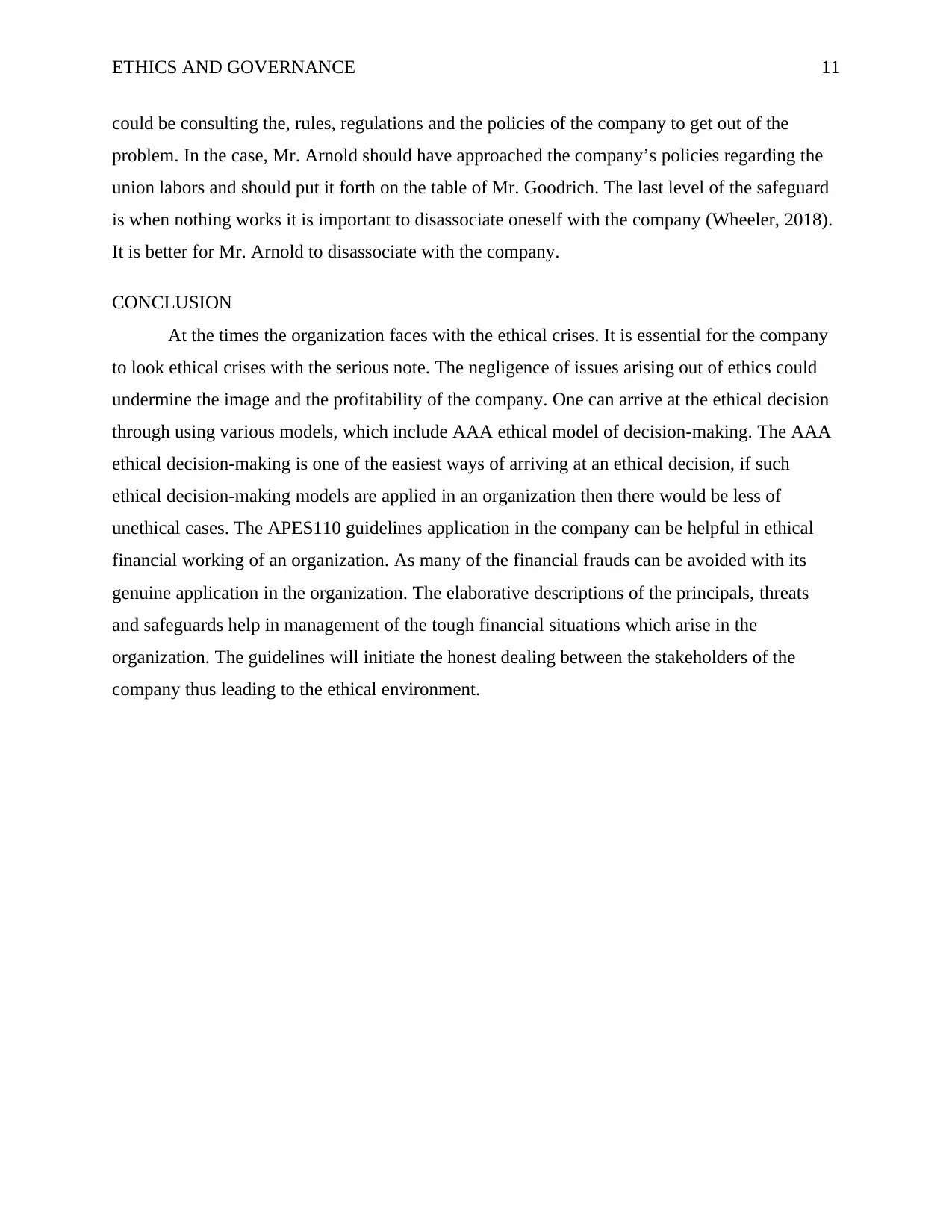
ETHICS AND GOVERNANCE 11
could be consulting the, rules, regulations and the policies of the company to get out of the
problem. In the case, Mr. Arnold should have approached the company’s policies regarding the
union labors and should put it forth on the table of Mr. Goodrich. The last level of the safeguard
is when nothing works it is important to disassociate oneself with the company (Wheeler, 2018).
It is better for Mr. Arnold to disassociate with the company.
CONCLUSION
At the times the organization faces with the ethical crises. It is essential for the company
to look ethical crises with the serious note. The negligence of issues arising out of ethics could
undermine the image and the profitability of the company. One can arrive at the ethical decision
through using various models, which include AAA ethical model of decision-making. The AAA
ethical decision-making is one of the easiest ways of arriving at an ethical decision, if such
ethical decision-making models are applied in an organization then there would be less of
unethical cases. The APES110 guidelines application in the company can be helpful in ethical
financial working of an organization. As many of the financial frauds can be avoided with its
genuine application in the organization. The elaborative descriptions of the principals, threats
and safeguards help in management of the tough financial situations which arise in the
organization. The guidelines will initiate the honest dealing between the stakeholders of the
company thus leading to the ethical environment.
could be consulting the, rules, regulations and the policies of the company to get out of the
problem. In the case, Mr. Arnold should have approached the company’s policies regarding the
union labors and should put it forth on the table of Mr. Goodrich. The last level of the safeguard
is when nothing works it is important to disassociate oneself with the company (Wheeler, 2018).
It is better for Mr. Arnold to disassociate with the company.
CONCLUSION
At the times the organization faces with the ethical crises. It is essential for the company
to look ethical crises with the serious note. The negligence of issues arising out of ethics could
undermine the image and the profitability of the company. One can arrive at the ethical decision
through using various models, which include AAA ethical model of decision-making. The AAA
ethical decision-making is one of the easiest ways of arriving at an ethical decision, if such
ethical decision-making models are applied in an organization then there would be less of
unethical cases. The APES110 guidelines application in the company can be helpful in ethical
financial working of an organization. As many of the financial frauds can be avoided with its
genuine application in the organization. The elaborative descriptions of the principals, threats
and safeguards help in management of the tough financial situations which arise in the
organization. The guidelines will initiate the honest dealing between the stakeholders of the
company thus leading to the ethical environment.
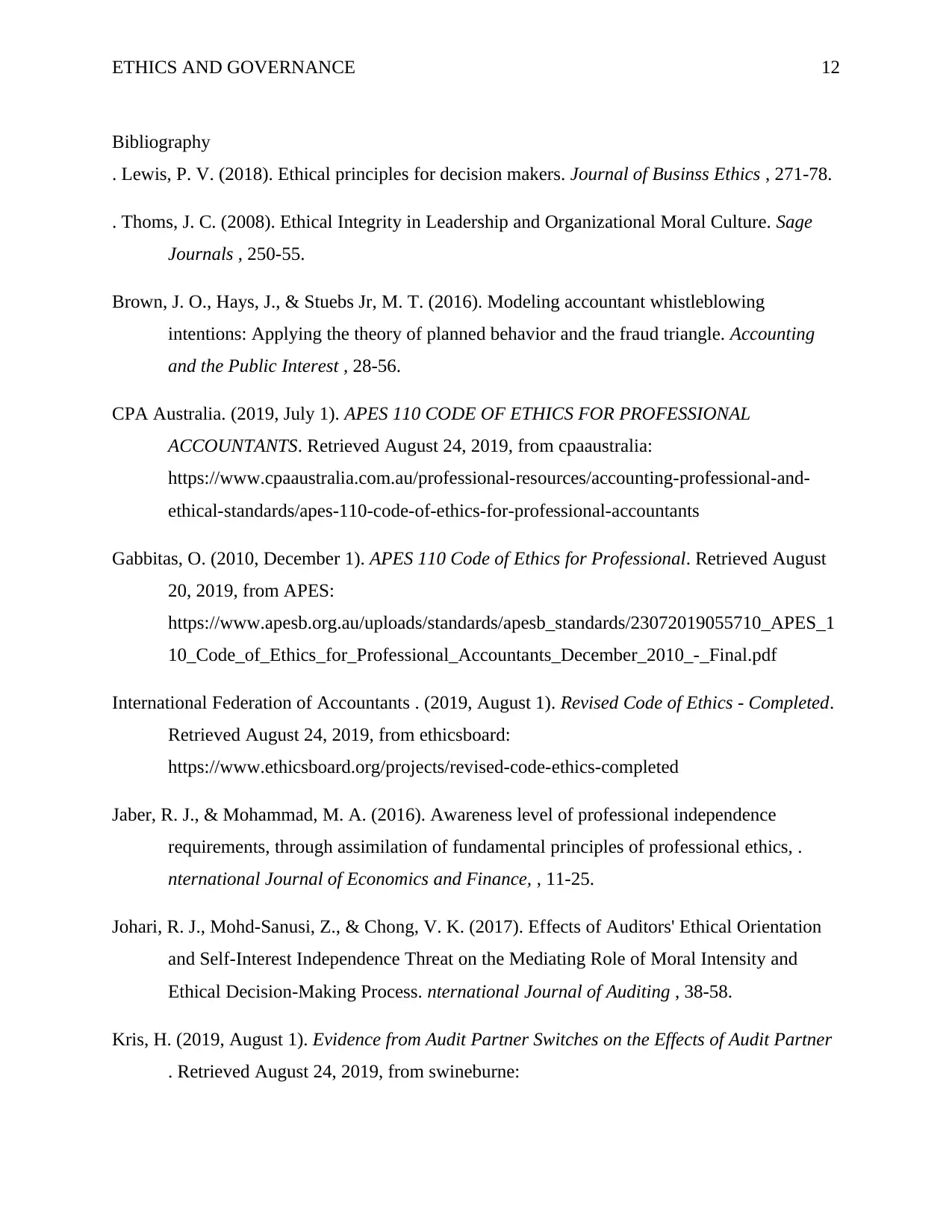
ETHICS AND GOVERNANCE 12
Bibliography
. Lewis, P. V. (2018). Ethical principles for decision makers. Journal of Businss Ethics , 271-78.
. Thoms, J. C. (2008). Ethical Integrity in Leadership and Organizational Moral Culture. Sage
Journals , 250-55.
Brown, J. O., Hays, J., & Stuebs Jr, M. T. (2016). Modeling accountant whistleblowing
intentions: Applying the theory of planned behavior and the fraud triangle. Accounting
and the Public Interest , 28-56.
CPA Australia. (2019, July 1). APES 110 CODE OF ETHICS FOR PROFESSIONAL
ACCOUNTANTS. Retrieved August 24, 2019, from cpaaustralia:
https://www.cpaaustralia.com.au/professional-resources/accounting-professional-and-
ethical-standards/apes-110-code-of-ethics-for-professional-accountants
Gabbitas, O. (2010, December 1). APES 110 Code of Ethics for Professional. Retrieved August
20, 2019, from APES:
https://www.apesb.org.au/uploads/standards/apesb_standards/23072019055710_APES_1
10_Code_of_Ethics_for_Professional_Accountants_December_2010_-_Final.pdf
International Federation of Accountants . (2019, August 1). Revised Code of Ethics - Completed.
Retrieved August 24, 2019, from ethicsboard:
https://www.ethicsboard.org/projects/revised-code-ethics-completed
Jaber, R. J., & Mohammad, M. A. (2016). Awareness level of professional independence
requirements, through assimilation of fundamental principles of professional ethics, .
nternational Journal of Economics and Finance, , 11-25.
Johari, R. J., Mohd‐Sanusi, Z., & Chong, V. K. (2017). Effects of Auditors' Ethical Orientation
and Self‐Interest Independence Threat on the Mediating Role of Moral Intensity and
Ethical Decision‐Making Process. nternational Journal of Auditing , 38-58.
Kris, H. (2019, August 1). Evidence from Audit Partner Switches on the Effects of Audit Partner
. Retrieved August 24, 2019, from swineburne:
Bibliography
. Lewis, P. V. (2018). Ethical principles for decision makers. Journal of Businss Ethics , 271-78.
. Thoms, J. C. (2008). Ethical Integrity in Leadership and Organizational Moral Culture. Sage
Journals , 250-55.
Brown, J. O., Hays, J., & Stuebs Jr, M. T. (2016). Modeling accountant whistleblowing
intentions: Applying the theory of planned behavior and the fraud triangle. Accounting
and the Public Interest , 28-56.
CPA Australia. (2019, July 1). APES 110 CODE OF ETHICS FOR PROFESSIONAL
ACCOUNTANTS. Retrieved August 24, 2019, from cpaaustralia:
https://www.cpaaustralia.com.au/professional-resources/accounting-professional-and-
ethical-standards/apes-110-code-of-ethics-for-professional-accountants
Gabbitas, O. (2010, December 1). APES 110 Code of Ethics for Professional. Retrieved August
20, 2019, from APES:
https://www.apesb.org.au/uploads/standards/apesb_standards/23072019055710_APES_1
10_Code_of_Ethics_for_Professional_Accountants_December_2010_-_Final.pdf
International Federation of Accountants . (2019, August 1). Revised Code of Ethics - Completed.
Retrieved August 24, 2019, from ethicsboard:
https://www.ethicsboard.org/projects/revised-code-ethics-completed
Jaber, R. J., & Mohammad, M. A. (2016). Awareness level of professional independence
requirements, through assimilation of fundamental principles of professional ethics, .
nternational Journal of Economics and Finance, , 11-25.
Johari, R. J., Mohd‐Sanusi, Z., & Chong, V. K. (2017). Effects of Auditors' Ethical Orientation
and Self‐Interest Independence Threat on the Mediating Role of Moral Intensity and
Ethical Decision‐Making Process. nternational Journal of Auditing , 38-58.
Kris, H. (2019, August 1). Evidence from Audit Partner Switches on the Effects of Audit Partner
. Retrieved August 24, 2019, from swineburne:
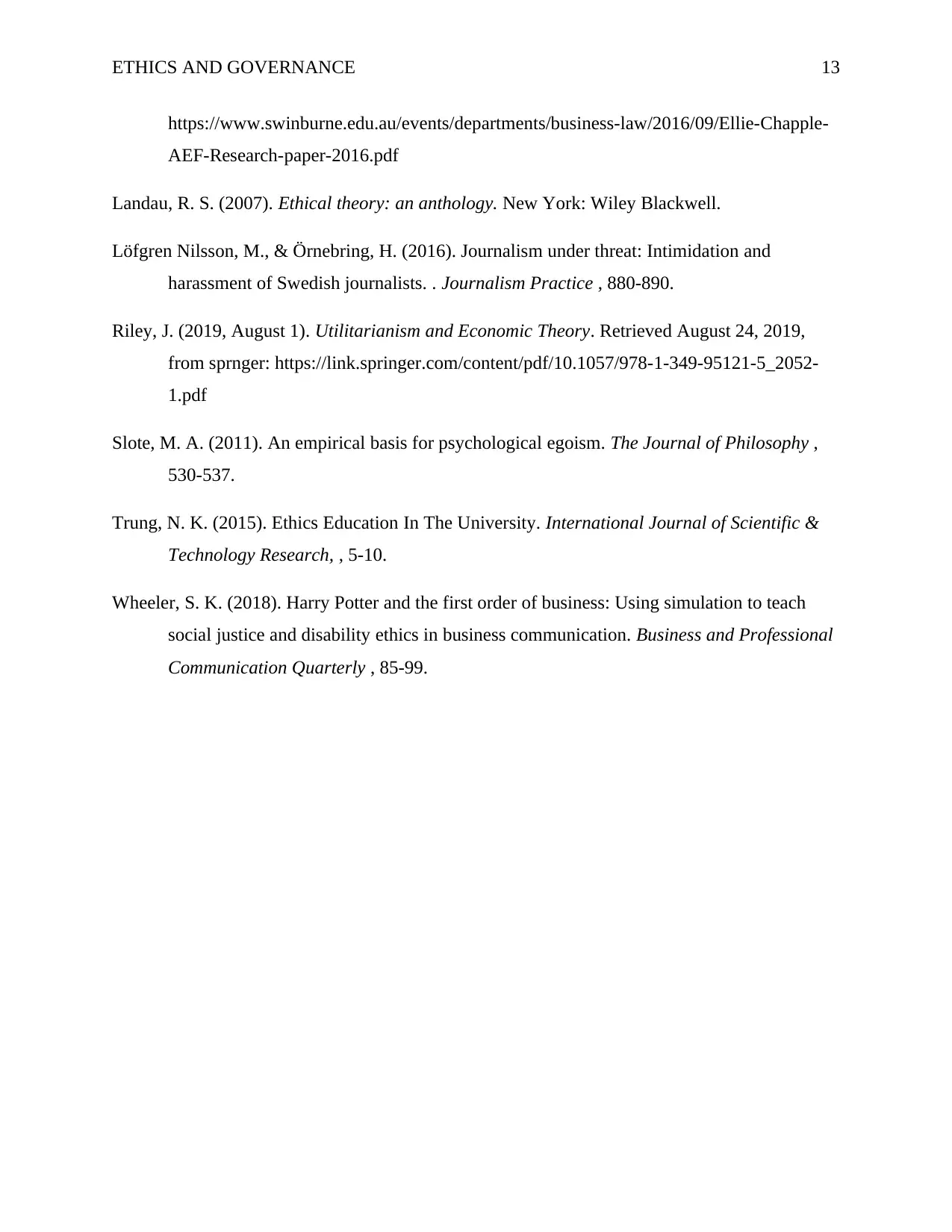
ETHICS AND GOVERNANCE 13
https://www.swinburne.edu.au/events/departments/business-law/2016/09/Ellie-Chapple-
AEF-Research-paper-2016.pdf
Landau, R. S. (2007). Ethical theory: an anthology. New York: Wiley Blackwell.
Löfgren Nilsson, M., & Örnebring, H. (2016). Journalism under threat: Intimidation and
harassment of Swedish journalists. . Journalism Practice , 880-890.
Riley, J. (2019, August 1). Utilitarianism and Economic Theory. Retrieved August 24, 2019,
from sprnger: https://link.springer.com/content/pdf/10.1057/978-1-349-95121-5_2052-
1.pdf
Slote, M. A. (2011). An empirical basis for psychological egoism. The Journal of Philosophy ,
530-537.
Trung, N. K. (2015). Ethics Education In The University. International Journal of Scientific &
Technology Research, , 5-10.
Wheeler, S. K. (2018). Harry Potter and the first order of business: Using simulation to teach
social justice and disability ethics in business communication. Business and Professional
Communication Quarterly , 85-99.
https://www.swinburne.edu.au/events/departments/business-law/2016/09/Ellie-Chapple-
AEF-Research-paper-2016.pdf
Landau, R. S. (2007). Ethical theory: an anthology. New York: Wiley Blackwell.
Löfgren Nilsson, M., & Örnebring, H. (2016). Journalism under threat: Intimidation and
harassment of Swedish journalists. . Journalism Practice , 880-890.
Riley, J. (2019, August 1). Utilitarianism and Economic Theory. Retrieved August 24, 2019,
from sprnger: https://link.springer.com/content/pdf/10.1057/978-1-349-95121-5_2052-
1.pdf
Slote, M. A. (2011). An empirical basis for psychological egoism. The Journal of Philosophy ,
530-537.
Trung, N. K. (2015). Ethics Education In The University. International Journal of Scientific &
Technology Research, , 5-10.
Wheeler, S. K. (2018). Harry Potter and the first order of business: Using simulation to teach
social justice and disability ethics in business communication. Business and Professional
Communication Quarterly , 85-99.
1 out of 13
Related Documents
Your All-in-One AI-Powered Toolkit for Academic Success.
+13062052269
info@desklib.com
Available 24*7 on WhatsApp / Email
![[object Object]](/_next/static/media/star-bottom.7253800d.svg)
Unlock your academic potential
© 2024 | Zucol Services PVT LTD | All rights reserved.





